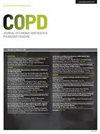Respiratory Oscillometry and Functional Performance in Different COPD Phenotypes
IF 3.1
3区 医学
Q1 Medicine
International Journal of Chronic Obstructive Pulmonary Disease
Pub Date : 2024-03-06
DOI:10.2147/copd.s446085
引用次数: 0
Abstract
Purpose: Chronic obstructive pulmonary disease (COPD) phenotypes may introduce different characteristics that need to be known to improve treatment. Respiratory oscillometry provides a detailed analysis and may offer insight into the pathophysiology of COPD. In this paper, we used this method to evaluate the differences in respiratory mechanics of COPD phenotypes.Patients and Methods: This study investigated a sample of 83 volunteers, being divided into control group (CG = 20), emphysema (n = 23), CB (n = 20) and asthma-COPD overlap syndrome (ACOS, n = 20). These analyses were performed before and after bronchodilator (BD) use. Functional capacity was evaluated using the Glittre‑ADL test, handgrip strength and respiratory pressures.
Results: Initially it was observed that oscillometry provided a detailed description of the COPD phenotypes, which was consistent with the involved pathophysiology. A correlation between oscillometry and functional capacity was observed (r=− 0.541; p = 0.0001), particularly in the emphysema phenotype (r = − 0.496, p = 0.031). BD response was different among the studied phenotypes. This resulted in an accurate discrimination of ACOS from CB [area under the receiver operating curve (AUC) = 0.84] and emphysema (AUC = 0.82).
Conclusion: These results offer evidence that oscillatory indices may enhance the comprehension and identification of COPD phenotypes, thereby potentially improving the support provided to these patients.
Keywords: asthma-COPD overlap, emphysema, chronic bronchitis, respiratory impedance, handgrip analysis, Glittre-ADL test, forced oscillation technique, bronchodilator response
不同慢性阻塞性肺疾病表型的呼吸振荡测量和功能表现
目的:慢性阻塞性肺病(COPD)的表型可能具有不同的特征,需要了解这些特征才能改进治疗。呼吸振荡测量法可提供详细分析,并可深入了解慢性阻塞性肺疾病的病理生理学。在本文中,我们使用这种方法来评估慢性阻塞性肺病表型的呼吸力学差异:本研究调查了 83 名志愿者,他们被分为对照组(CG = 20)、肺气肿组(n = 23)、CB 组(n = 20)和哮喘-慢性阻塞性肺病重叠综合征组(ACOS,n = 20)。这些分析是在使用支气管扩张剂(BD)之前和之后进行的。使用格利特-ADL 测试、手握力和呼吸压力对功能能力进行了评估:初步观察发现,示波法能详细描述慢性阻塞性肺病的表型,这与相关的病理生理学是一致的。振荡测量与功能能力之间存在相关性(r=- 0.541;p=0.0001),尤其是在肺气肿表型中(r=- 0.496,p=0.031)。在所研究的表型中,BD 反应是不同的。这导致了 ACOS 与 CB(接收器工作曲线下面积(AUC)= 0.84)和肺气肿(AUC = 0.82)的准确区分:这些结果证明,振荡指数可增强对 COPD 表型的理解和识别,从而有可能改善为这些患者提供的支持。 关键词:哮喘-COPD 重叠、肺气肿、慢性支气管炎、呼吸阻抗、手握分析、Glittre-ADL 测试、强迫振荡技术、支气管扩张剂反应
本文章由计算机程序翻译,如有差异,请以英文原文为准。
求助全文
约1分钟内获得全文
求助全文
来源期刊

International Journal of Chronic Obstructive Pulmonary Disease
RESPIRATORY SYSTEM-
CiteScore
5.10
自引率
10.70%
发文量
372
审稿时长
16 weeks
期刊介绍:
An international, peer-reviewed journal of therapeutics and pharmacology focusing on concise rapid reporting of clinical studies and reviews in COPD. Special focus will be given to the pathophysiological processes underlying the disease, intervention programs, patient focused education, and self management protocols. This journal is directed at specialists and healthcare professionals
 求助内容:
求助内容: 应助结果提醒方式:
应助结果提醒方式:


